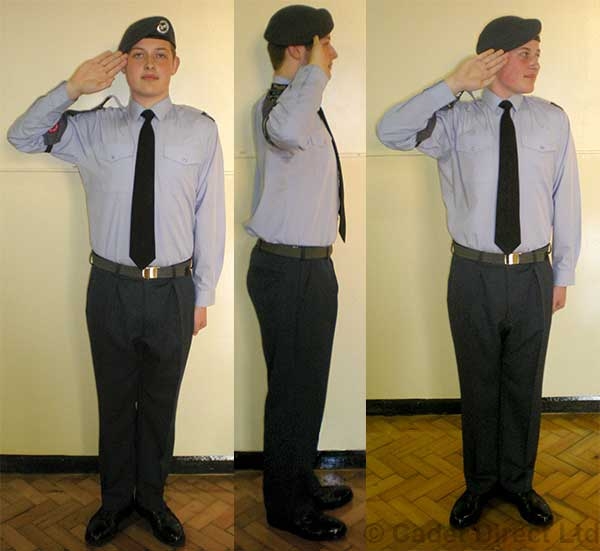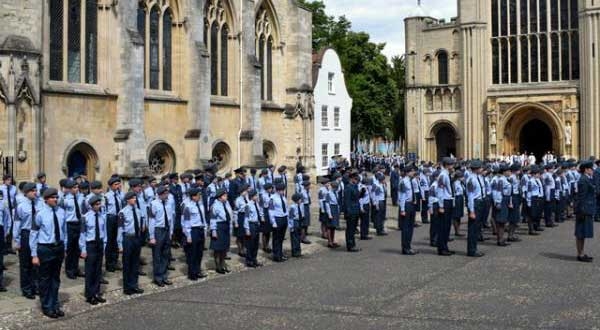Introduction to Air Cadet Drill
Throughout history, drill has been the foundation upon which discipline, teamwork, pride and pageant have all taken equal part. In the days of the ‘Brown Bess’ musket, when in battle, the infantry formed a square in their three ranks in order to give effective firepower.
This action was carried out as a drill, taught and practiced on the barrack square. The discipline required to ‘hold the line’ was the difference between defeat and victory.
Drill parades were hard and rigorous, with harsh violence dished out by the instructors.
Times have changed, all services yet they still rely on drill to build team spirit and to train the individuals mind to respond to orders given in the quickest possible time.
When you are first introduced to drill commands, you may find that your reactions are slow and mistakes easily made. Fortunately your initial lessons are all completed at the ‘Halt’ i.e. stood still. It is difficult enough to stand still, especially when there is a fly walking down your nose - no matter, stand still!
Once you have mastered the initial movements and been taught how to march without your arms moving in the wrong order, you will suddenly find it all comes together, your squad starts to move as a team.
It will probably feel even better when you take part in a Civic or Cadet Sunday Parade. You will be with the rest of your Squadron, smartly turned out and marching behind a band.
It might sound odd to those of you who have not attended such Parades, but it gives you a real ‘Buzz’ and dare it be said, pride in your Squadron and the Air Training Corps. (Particularly if your family and friends are watching!)
REMEMBER: DO NOT WEAR YOUR UNIFORM WITHOUT PERMISSION FROM YOUR SQUADRON COMMANDER UNLESS YOU ARE ON CADET DUTIES
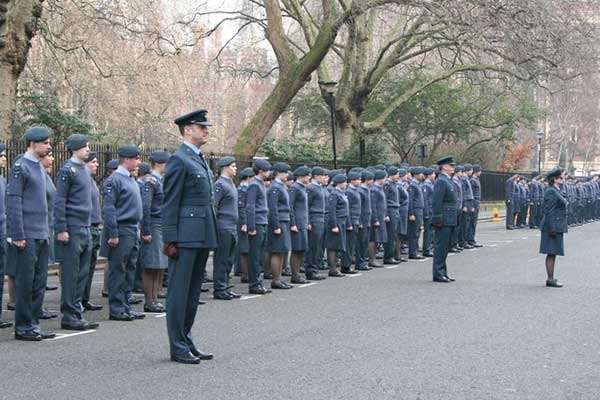
DRILL - INTRODUCTORY WORDS OF COMMAND
USED FOR SQUAD DRILL
Good instructors give INTRODUCTORY words of command giving warning of what the next word of command is to be. Many instructors do not do this; the result is the squad turning in different directions at the same time!
Before moving a squad in any direction, the instructor indicates what direction they intend to move them by using INTRODUCTORY words of command, before giving the actual command to execute the movement.
TEACHING DRILL
The aims of drill are:
I. To produce a Cadet who has self respect, is alert and obedient
2. To provide the basis for teamwork
Drill is exacting and strict attention to detail must be observed. You will need the following qualities to become an excellent drill instructor.
I. PATIENCE. Never lose your temper.
2. ENTHUSIASM. You must fire your squad with a will to achieve.
3. CONSISTENCY. Set yourself and the squad a high standard and do not deviate from it.
4. HUMANITY. Understand the squad’s problems; praise readily,
5. PERSONALITY. As a drill instructor you must impress your squad - always have them under control, lead by example:
I. Always be impeccably turned out.
2. When drilling a squad, stand to attention, always face them.
3. When moving, march as you would wish your squad to march - no ‘bimbling.’
4. When demonstrating, be accurate; never exaggerate a drill movement. If the movement is with a rifle use that article and nothing else.
5. Never use bad language and sarcasm; it is the sign of a poor instructor.
6. Ensure that your words of command are clear, DO NOT do as some drill instructors, create your own ‘drill language’, it is bad practice.
7. Do not become over familiar or humiliate individual members of your squad.
COMPLIMENTS
Saluting - Origin and Information
The salute with the hand, the present arms to senior offices and the salute with the sword were methods by which the person paying a compliment could show the person to whom the compliment was paid that no offence was meant and they were unarmed.
They were all gestures symbolic of loyalty and trust.
A salute is the normal greeting between comrades in arms. That a salute is properly and smartly given when you meet an officer is a basic matter of discipline.
That the salute is properly and smartly given is a matter of training. Failure by an officer to return a salute shows a lack of courtesy on their part.
THE QUEEN'S COMMISSION
All compliments derive their origin from the Sovereign, to whom the highest compliment, the Royal Salute, is paid.
PAYING COMPLIMENTS - SALUTING
Saluting to the front - Common Faults
1. The body and head not remaining still and erect.
2. Allowing your right elbow to come forward.
3. Hand not flat and in correct position, finger tips not near to head at eye level.
4. Wrist bent - not in straight line with forearm.
5. Allowing left arm to creep forwards.
6. Left fist not clenched with thumb to front, arm not tight into side.
NOTE: As an aid to good saluting, remember your right hand - with the palm
of your hand flat, thumb on top, travels the `longest way up and the shortest
way down' when you are saluting correctly.
THE QUEENS COMMISSION
All officers in the Air Training Corps are holders of the Queen's Commission, and when compliments are paid by saluting it is in recognition of the Sovereign’s Commission held in trust by that officer.
The actual commission an officer receives is in fact a document on parchment paper signed and sealed by Her Majesty The Queen.
Ask one of your officer to bring theirs along for you to see, it is a very special and interesting document.
DEFINITIONS USED IN DRILL
ALIGNMENT: Any straight line on which a body of cadets is or are to form.
CLOSE ORDER: Formation of a flight or squad in three ranks (3 ranks)

Each cadet in the centre and rear ranks covering the corresponding cadet in the front rank. Distance of 75cm (30 inches).
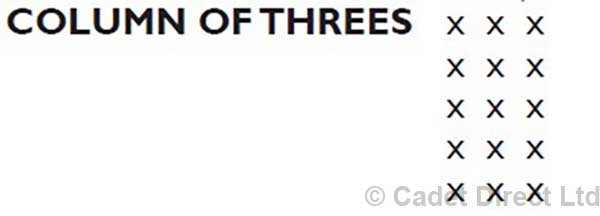
A succession of cadets standing side by side in threes, covering the front files as in diagram above. Normal formation for marching on a road.
COVERING: As in both of the illustration above, one behind the other covering off the front files.
DIRECTING FLANK: Flank by which units march and dress, "By the Left/Right".
FILE: Any cadet in the front rank together with the cadet(s) immediately behind them.
FLIGHT: A sub-unit, two or more of which comprise a squadron. (approximately size of Army or Navy platoon)
FORMATION: A number of units grouped together under one commander.
FRONT: The direction in which units are facing or moving at any given time.
FRONTAGE: The extent of ground covered laterally by a body or bodies of cadets.
GUARD OF HONOR: A parade not exceeding 100 cadets formed to present formal ceremonial compliments to royal or residential persons.
HALF GUARD: A parade not exceeding 50 cadets formed to present ceremonial compliments to other particular distinguished persons.
INCLINE: Half a turn, you move through 45 degrees.

MARKER: An NCO or cadet positioned to mark a point where the flank of a squad or unit is to rest/dress.
OPEN ORDER: Flight in three ranks with three paces between the ranks. (3 ranks). This affords space for inspections to be carried out.
OPEN ORDER: Flight in two ranks, with four paces between ranks. (2 ranks)
PIVOT FLANK: The flank on which a unit pivots when changing direction.
PIVOT GUIDE: The guide on a pivot flank of a unit.
QUARTER GUARD: A small ceremonial guard, that may be mounted at the main entrance to a unit to pay compliments as required. Not to be confused with a Guard of Honor. Guard consists of 1 officer, 1 SNCO plus 6 other corporals and cadets. They form up in two ranks.
REVIEW: A ceremonial parade formed to honor a particular person.
SQUAD: Small body of cadets formed as working party etc.
SQUADRON: A unit of two or more flights (subunits), Approximately same size as Army/Navy company.
SUPER: Extra ranks formed behind rear rank of unit,
NUMERARY: comprising of officers and SNCO’s.
TO CANT: To incline or tilt an object.
TO DRESS: To adjust and take up the correct alignment.
WHEELING: A drill movement by which a body of cadets bring forward a flank on a fixed or moving pivot.
WING: Formation consisting of two or more squadrons or units. (approx same size as Army Battalion or Navy Division).
COMMANDS, TIMINGS AND EXCUTION
TURNINGS and INCLINES
| COMMAND | TIME/PACE |
WHEN EXECUTIVE COMMAND IS GIVEN |
| “About” - “TURN” | Quick |
As the LEFT HEEL strikes the ground. |
| “About” - “TURN” | Slow |
As the LEFT FOOT is on the ground. |
| “Right” - “TURN” | Quick |
As the LEFT HEEL strikes the ground. |
| “Right” - “TURN” | Slow |
As the LEFT FOOT is on the ground. |
| “Right” - “INCLINE” | Quick |
As the LEFT HEEL strikes the ground. |
| “Right” - “INCLINE” | Slow |
As the LEFT FOOT is on the ground. |
| “Left” - “TURN” | Quick |
As the RIGHT HEEL strikes the ground. |
| “Left” - “TURN” | Slow |
As the RIGHT FOOT is on the ground |
| “Left” - “INCLINE” | Quick |
As the RIGHT HEEL strikes the ground. |
| “Left” - “INCLINE” | Slow |
As the RIGHT FOOT is on the ground. |
HALTING
| COMMAND | TIME/PACE | WHEN EXECUTIVE COMMAND IS GIVEN |
| “HALT” | Double Time |
As the LEFT FOOT strikes the ground. |
| “HALT” | Quick Time |
As the LEFT HEEL strikes the ground. |
| “HALT” | Slow Time |
As the RIGHT FOOT is on the ground. |
| “HALT” | Mark Time |
As the LEFT FOOT strikes the ground. |
COMPLIMENTS
| COMMAND | TIME/PACE | WHEN EXECUTIVE COMMAND IS GIVEN |
|
“Eyes” - “LEFT/RIGHT/FRONT” |
Quick |
As the LEFT HEEL strikes the ground |
| “Eyes” - “LEFT/RIGHT/FRONT” | Slow | As the RIGHT FOOT strikes the ground |
|
To “LEFT/RIGHT/FRONT” "SALUTE" |
Quick |
As the LEFT HEEL strikes the ground. |
| To “LEFT/RIGHT/FRONT” "SALUTE" | Slow | As the LEFT FOOT strikes the ground. |
MARCHING
| COMMAND | TIME/PACE | WHEN EXECUTIVE COMMAND IS GIVEN |
| “Step - “OUT/SHORT” | Slow & Quick | As the LEFT HEEL strikes the ground. |
| “Change” -“STEP” | Quick | As the RIGHT HEEL strikes the ground. |
| “Change” -“STEP” | Slow | As the RIGHT FOOT is on the ground. |
| “Quick” - “March” | From Slow | As the LEFT HEEL strikes the ground. |
| “Slow” - “March” | From Quick | As the LEFT HEEL strikes the ground. |
| “Break into slow time”"SLOW MARCH" | From Quick Time | As the LEFT HEEL strikes the ground. |
MOVING OFF WITH A PRECEDING UNIT
| COMMAND | TIME/PACE | WHEN EXECUTIVE COMMAND IS GIVEN |
| “Quick” - “MARCH” | Quick |
As their RIGHT HEELS strike the ground. |
| “Slow” - “MARCH” | Slow |
As their RIGHT FEET strike the ground. |
USEFUL INFORMATION ON DRILL
Length of Paces in Marching.
Slow March - 75cm (30inches)
Quick March - 75cm (30inches)
March Sideways - 30cm (12inches) “ x Paces”
“Left” or “Right Close” -”MARCH”
Maximum number of five paces.
Stepping Short - 53cms (21inches)
Stepping Out - 83cms (33inches)
Stepping Forward/Backward - 75cms (30inches)
“ X Paces” “Forward/Backward” “MARCH”.
Maximum number of five paces.
PACES/TIME IN MARCHING
Slow March - 65 Paces per minute.
Quick March - 116 Paces per minute.
Sideways Marching and Stepping Forward or Backward - 116 Paces per minute.
ADJUSTING ON PARADE
The term "Adjusting on parade", is when you feel that your boot lace has come undone, or your shirt is coming out of your trousers or even worse
is left to your imagination, but you must put it right before some disaster happens.
So you ADJUST ON PARADE as explained below:-
Place your RIGHT FOOT 12 inches to the rear, make the required adjustment and return to your previous position.
Should you be carrying a Rifle - GROUND ARMS first.
If you are stood AT EASE, always come to ATTENTION before carrying out the ADJUSTMENT drill.
SIZING A SQUAD
This is a simple method of sorting out the different heights of cadets in a flight or squadron so as they appear more uniform when seen as a marching body.
This is especially important if you have some very small and very tall cadets in the flight or squadron as they would look most odd marching next to each other.
You have all the cadets form a single rank with the tallest at one end and the shortest at the other. The words of command are as follows:-
1. “Tallest on the RIGHT, shortest on the LEFT, in single rank” - “SIZE” (Cadets quickly sort themselves out to form the single rank)
2. “Squad” - “NUMBER” Starting with the RIGHT HAND cadet who shouts out “ONE”, followed by the next who shouts “TWO” and this follows down the file until all have numbered themselves.
3. “Odd numbers, two paces forward” - “MARCH”. Even numbers stand still.
4. “Number one stand fast” “Ranks RIGHT and LEFT” - “TURN”. The front rank formed by the ODD NUMBERS turn to their RIGHT. The rear rank formed by the EVEN numbers turn to their LEFT.
5. “Form Flight” - “Quick” - “MARCH”. The leading cadet of the REAR file wheels to the right followed by the remainder joining the end of the front file.
As this is taking place the first two cadets of the front file march to the rear of number one, turn to the front, take up a position covering off number one. The remainder of the cadets continue to fill the Front, Centre and Rear Ranks in that order, until the squad is formed.
INSPECTION OF A SQUADRON/FLIGHT
To make room between the ranks all inspections are carried out at the Open Order.
Each Rank is stood to attention while being inspected, while those who are waiting or who have been inspected are Stood At Ease.
The Words of Command that you will be given are as follows:-
1. “Squad”- "Squad" -”SHUN”.
2. “Open Order” - “MARCH”, “Right” - “DRESS”, “Eyes” -“FRONT”.
3. “Centre and Rear Ranks, Stand At” - “EASE”.
4. “Centre Rank "SHUN”, “Front Rank”,“Stand At” - “EASE”.
5. “Rear Rank "SHUN”, “Centre Rank”,“Stand At” - “EASE”.
6. “Rear Rank, stand at” “EASE”, “Flight - SHUN"
7. At the end of the inspection ask permission from the inspecting officer to fall out.
8. "Squad"- "Squad"-"Shun" - Officer on parade - "Fall Out".
MARCHING AND DRESSING OFF
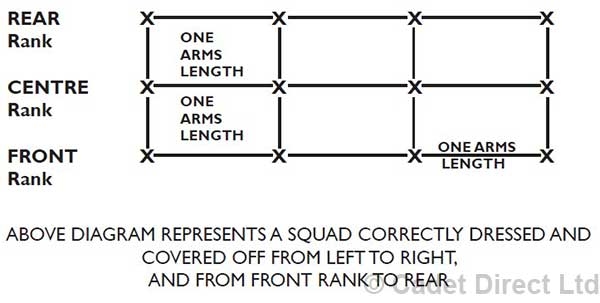
CHANGING DIRECTION - WHEELING ON THE MARCH
Right Hand Cadet Centre and Left Hand of Leading File Cadets lengthening turns through their pace. (90°)
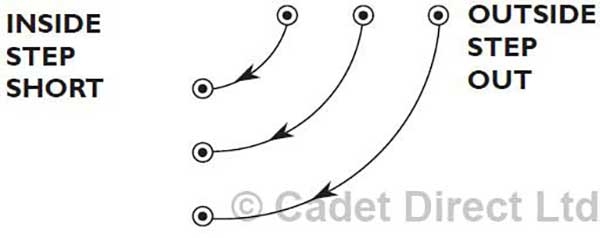
The term "Step Short" means reduce the length of your pace, "Step Out" means slightly lengthen your pace. By doing this while Wheeling you keep your dressing in each file as it changes direction.
A common fault when giving the "Left or Right Wheel" is for the command to be given sharply, when in fact it should be drawn out - "WHEE-EEL", allowing the files to slowly change direction, keeping their dressing in threes.
WORDS OF COMMAND
The information below is perhaps the most important for you to learn and practice, as it is only when you are able to correctly give yourself these
words of command that you will become good at drill.
The commands given are for when you are "on the march" or "marking time". Like many skills it is only with practice that you will become perfect.
All words of command must be clear and powerful since the way in which they are given affects the reaction that they inspire. The word of command is divided into three parts:
a. Introductory. This tells the squad what movements they are about to carry out ie “Into Line”.
b. Cautionary. The drawn out and loud reminder to the squad ie “Right”.
c. Executive. The high-pitched, sharp command ie “Turn”.
Sometimes there is no need for an introductory word of command ie “Forward”. The following are examples of the delivery of a word of command:
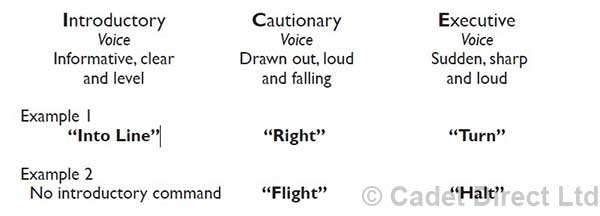
DEVELOPING YOUR WORD OF COMMAND
The following information will help you develop good voice control. Practice whenever you can.
Explanation: Many drill instructors end up with sore throats after a prolonged drill practice. This may well be because they do not use their lungs correctly.
It is important to breathe in through your nose and take your breath ‘right down to your stomach’. In other words, learn to breathe deeply. When giving a word of command, ‘push’ the air out.
Do not forget to stand to attention when giving commands. Standing with your feet apart or leaning backwards may result in straining your groin. KEEP YOUR WEIGHT FORWARD AND YOUR FEET TOGETHER. Have your head up, looking directly at your squad; when giving the word of command AIM your voice straight over the squad.
Giving Words of Command
Giving a cautionary or preliminary word of command you have to pitch your voice on the same note to ensure that it does not ‘tail away’ at the
end. It must be short and sharp, “SQD”. Then comes the executive word of command, equally short and sharp, “SHUN”.
It is most important to develop the correct method of delivering commands; nothing is worse than a poor drill instructor. If you really cannot do it properly, leave it to someone who can.
Words of Command
They must be pronounced CLEARLY. It is not just a sound. A quick tightening of the stomach muscles so that the word comes out quick, a lower pitch to give the Introductionary, short and higher in pitch than the Cautionary produces the Executive word of command.(remember ICE).
Ensure that there is a pause between the Cautionary and the Executive. Failure to do this may result in the flight anticipating the word of command, thus the whole purpose of drill is lost - and chaos will reign!
Note: Use your mouth; the wider open it is, the louder the sound!

Drill Instructors Qualities
Drill is exacting and to teach it successfully the instructor must have the following qualities:
a. Patience – never lose your temper.
b. Enthusiasm – you must inspire your squad with a will to learn.
c. Consistent Attitude – set the standard and do not deviate from it.
d. Humanity – understand the squad’s problems. Praise readily but do not become familiar, and never humiliate individual members of the squad.
e. Strength of Personality – as a drill instructor you must impress the squad with your personality and always control them fully.
EXAMPLE: Recruits imitate their instructors and it is by example that they will learn most.
So you must:
a. When drilling a squad, stand at Attention.
b. When moving, march as you would wish your squad to march.
c. When demonstrating, do so accurately and if the movement is with a rifle, use a rifle and nothing else.
d. Do not use foul or abusive language.
e. Be impeccably turned out.
f. Never exaggerate a movement of drill.
Sequence of Instructing Drill
The following sequence is to be used:
a. Form the squad.
b. Explanation.
c. Demonstration.
d. Questions.
e. Practice, which should be collective, then individual and collective again
Formation of a Squad: Keep in mind 2 issues:
a. Consider the comfort of the squad. Make sure that they are not looking into the sun or are unnecessarily exposed to the elements.
b. Consider the formation in which they will learn most quickly. The following is a guide:
| Use | Formation |
| Foot Drill | Straight Line/Hollow Square |
| Rifle Exercise | Half Circle |
| Saluting at the Halt |
Three Ranks, Open Order,Inclined to the Right |
Explanation: Explain what you are about to teach and why it is necessary.
Demonstration. Broken down as follows:
a. Complete demonstration, calling out the words of command.
b. Demonstration by numbers, pointing out important details.
c. Another complete demonstration.
Questions: After giving the first demonstration by numbers, ask the squad if they have any questions and do so after each subsequent demonstration by numbers.
Practice: After each demonstration by numbers, practise the squad in that movement, checking for faults. Finally, after demonstrating the whole movement, practise the squad judging the time.
DRILL TECHNIQUES TO AID INSTRUCTION
To achieve common standards of drill instruction in the Royal Air Force the following instructional techniques are to be used:
a. Regulation Pause: The regulation pause is equal to 2 beats in Quick Time.
When spoken in the course of instruction this pause is represented by the words “LEFT RIGHT”.
b. Movements: Parts of a drill movement are to be represented by the word “ONE”
SAFETY
Before each lesson or drill practice normal safety precautions (NSPs) areto be carried out on rifles. Due regard is to be given to the safe handling of bayonets.
AIDS TO DRILL INSTRUCTION
1. Calling out the Time. Personnel in the early stages of training should call out the time until considered proficient. They must learn to be still when calling out “LEFT RIGHT” for the regulation pause. Calling out the time will enable:
a. Every member of a squad to implement the regulation pause.
b. The squad to learn to act together.
2. Time and Pace (this includes the lengths of pace, rates of marching and timings of movements).
3. Mechanical Aids: There are three aids the instructor may use to help obtain accurate and smart drill. They are as follows:
a. The Pace Stick. The pace stick is used to gauge the correct length of pace and to measure the distance between ranks. It is a difficult instrument to wield and perfection in the art of turning it, requires constant practice. The instructor should march beside the leading person of the squad, with the stick open and turning to control the length of pace. The instructor should periodically check the length of pace by marching behind the squad with the pace stick open and turning (only carried by authorsied drill instructor by the Adult Training Facility)
b. The Metronome:This gives an accurate check on the rate of marching and on the timing of rifle exercises. It can be set to any number of beats per-minute and should be used frequently to maintain uniformity of instruction with regard to timings. The electronic metronome with an LCD readout is replacing the swinging arm version.
c.The Drum: When foot drill and rifle exercises are being taught by numbers at the halt, a drummer may be used by the instructor to provide the cue for a movement.
Three scenarios are as follows:
(1) The drummer is stationed behind the squad and will judge the regulation pause between the cautionary word of command and the drum-tap. The squad will react more sharply to the tap of the drum than they would to the instructor’s word of command.
(2) When foot exercises are being done at the halt whilst judging the time, station a drummer to the rear of the squad. The drummer should have a metronome (set at 40) and should be far enough behind the squad for them not to hear the tick of the metronome. The drummer will judge the regulation pause between the command and his first tap, if this is possible. Thereafter he will tap the drum on every beat of the metronome for the same number of times as there are movements.
(3) To beat the rate of marching, set the metronome to the rate required. The drummer now beats in time with the metronome and the squad stands still and listens. When the instructor is ready to practise his squad he must have the drummer beating the time to the metronome and then give: “QUICK MARCH”
To summaries:
Remember: Introductory, Cautionary, Executive - ICE
Power: Plenty of air into the lungs.
Pitch: Hold your head high and pitch the word of command high over the squad.
Punch: Given quickly by tightening the stomach muscles.
Pronunciation: Make your words CLEAR, LOUD, AS AN ORDER.
COMMUNICATION DRILL
This Drill introduces an element of 'fun' into a Drill Lesson. It gives the individual Cadet the opportunity to use their voice as never before as they are competing with each other to make themselves heard above the rest of the Squad.
I. First demonstrate to the squad all words of command at the halt, including rifle drill if taught.
2. Then “conduct” the squad while they give elementary words of command; insisting on clarity and power from each cadet.
3. Divide the squad in to two ranks, place them about 25 meters apart, with 5 paces interval between each cadet.
4. Each cadet should now drill his/her opposite number 25 meters away without regard to those to the left or right of them.
5. After no more than ten minutes, change the ranks, so that the cadets in both ranks have a chance of controlling their opposite number.
MUTUAL DRILL
Form the squad into three ranks and explain the introductory word of command and which are the DIRECTING FLANK. Call out each member of the squad in turn to drill the squad and then call out another member of the squad to watch and be prepared to comment on his/her performance.
Note:
I. Be patient and make encouraging comments.
2. When correcting, be sure you address your remarks to the whole squad, they can all learn by one cadet’s mistakes.
Testing your wits
'Ogrady' is a game practiced to sharpen your response to an order. If the instructor precedes an order with "OGRADY SAYS" then you carry it out, if not, any who move are 'knocked out" the last Cadet is the winner.

